
 Reconstructing the Past Reconstructing the Past |
|||||
| Indian Archaeological Sources | Indian Literary Sources |
Reconstructing the Past - 03
Indian Historical Sources - II
As stated in the previous monograph, the history of India is divided into four periods by current historians:
- Ancient India (earliest times - 6th century AD),
- Early Medieval India (6th century AD - 13th century AD),
- Medieval India (13th century AD - 18th century AD), and
- Modern India (18th century - present).
The chart (Fig. ) of the Indian dominions which rose and fell over the ages will serve as a reference for time lines of the various kingdoms mentioned in the following writeup.
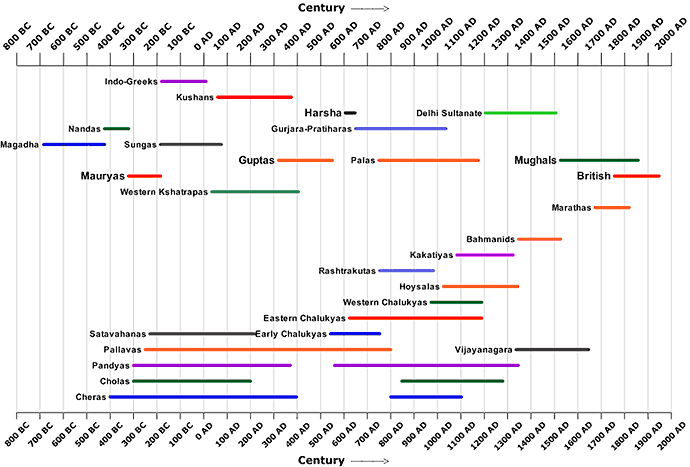
Literary Sources
The problem with Indian history, especially with the ancient, has been the deficiency of literary sources. There were hardly any scholars then who dealt with history as an academic discipline. Though ancient India has a rich heritage of religious texts and literature, it lacks historical works. In comparison, the scholars of Greece and Rome of those times had systematically documented their period.
According to Keay (India History, p. xvii), considering that there was four thousand years of pre-Islamic civilisation in the subcontinent, there has been no written records for about 80% of Indian history.
This unfortunate poverty of ancient historical literature of one of the oldest and richest civilisations, however, has been made up for by information gleaned from religious and secular literature, and from archaeology, epigraphy and numismatics.
It is only from the beginning of the Medieval period that Muslim scholars started writing histories to document the triumph of Islam.
For the Modern period, there is no dearth of historical works. Official records are available aplenty. Memoirs, biographies and travel accounts of Englishmen brush the 18th and 19th centuries with different perspective. Newspapers reflected opinions and provided chronology of events.
What follow are some important examples of literary sources, which are by no means exhaustive.
Historical Literature
Historical works
Kalhana is known as India's first historian. He composed a book titled Rajatarangini in 1150 AD, also known as the Kashmir Chronicle, which dealt with the history of Kashmir before 7th century AD, and comes nearest to a regular historical text.
With the advent of the Medieval period, historical writing came to life. Minaj-us-Siraj wrote Tabakati Nasiri, a general history of the Islamic world. Amir Khusrau's Khazain-ul-Fatah gives details on the period of Alauddin Khilji of the Delhi Sultanate. Abul Fazl's Akbar-nama and Ain-i-Akbari are great sources on the reign of the Mughal emperor Akbar.
The Modern period saw the maintenance of records of activities and transactions by the Europeans – the Portuguese, the Dutch, the French and the English – in India. These records (held today in the respective countries and in the Indian national and state archives), along with works of English and Indian authors like Lord Curzon, W.W. Hunter, Sir Alfred Lyall, S.N. Banerjea and Dr Rajendra Prasad, provide ample material for historians to work with.
Biographies
Ashvaghosha wrote Buddhacharita – biography of the Buddha – in the form of a poem in the 1st/2nd century AD. Harshacharita by Bana Bhatta (7th century AD) is a biography of king Harshavardhana. Bilhana's Vikramadevacharita (12th century) is about the Chalukya kings, in particular Vikramaditya IV. Chand Bardai, court poet Rajput king Prithviraja Chauhan wrote Prithviraja Raso (11th century AD) dealing with the king's exploits. Sandhyakosa Nandi's Ramcharita pertains to king Ramapala of Bengal (11th - 12th century).
Tuzuk-i-Babari (Babur-nama), the memoirs of Babur (founder of the Mughal dynasty) describes Hindustan of his period. Gulbadan Begum, daughter of Babur and sister of Humayun, wrote Humayun-nama, a biography of Humayun, the second Mughal emperor. Jahangir's memoirs, Tuzuk-i-Jahangiri, is an important text concerning the Mughal history.
In the Modern period, Mahatama Gandhi's autobiography My Experiments with Truth, Jawaharlal Nehru's autobiography Towards Freedom, and Judith Brown's biographies on Gandhi are great sources on perspectives on the Indian national struggle for freedom from the British rule.
Religious & Mythological Literature
Brahmanical Literature
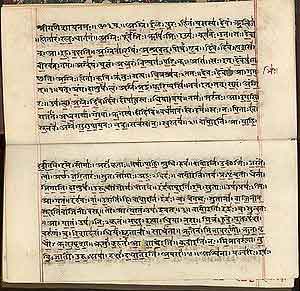
The Brahmanical literature consists of the Vedas, the EpicsAn epic is a long poem narrating the heroic story of a historical or legendary figure., the Puranas, the Vedangas and the Dharmasutras. These texts convey the religious beliefs and practices of the brahmins, and as a source for history, they provide information on the society in the northern and north-western India in the during the 2nd and 1st millennium BC.
The Vedas had have been composed and orally transmitted hundreds of years before they were written. From the study of the old Sanskrit of the Vedas, historians noticed its similarity with Greek and Latin, and developed the theory of a common ancestral language – the Indo-European. This helped link the ancestry of the Vedic people to central Asia.
The Vedas are supposed to contain eternal truths realised by rishis through meditation or revealed to them by the gods. They are a collection of hymns, prayers, sacrificial rituals, magic and nature poetry. There are four Vedas:
- Rig Veda, a collection of 1028 hymns in praise of gods and creation,
- Sama Veda, containing hymns, mostly from Rig Veda, to be chanted during sacrifices in which the juice of the Soma plant was offered,
- Yajur Veda, dealing with details of rituals and sacrifices, and
- Atharva Veda, dealing with spells, magic and charms.
Each Veda has four parts – the Samhita, Brahmana, Aryanka and Upanishad. The Samhitas are the core collection of hymns, prayers and spells of the Vedas. They are often mistakenly referred to as the Vedas. The Brahmanas are explanations of the Samhitas and give details of rituals and outcomes. The Aryankas (forest books) give philosophical interpretations of the rituals. The Upanishads, also called Vedantas, deal mostly with the philosophy of atman (soul) and brahman (ultimate spiritual reality of the universe).
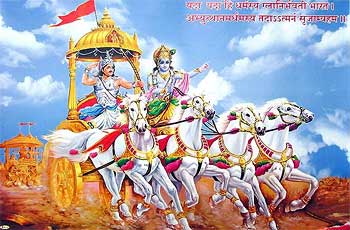
Many historians take c. 1500-1000 BC for the period of composition of the early Vedic literature (comprising the Samhitas), and c. 1000-500 BC for the later Vedic texts, comprising the Brahmanas, Aryankas, Upanishads, later versions of the Samhitas, the Epics, the Puranas, the Vedangas and the Dharmasutras.
The Ramayana (composed 5th century BC - 3rd century AD by Valmiki) and the Mahabharata (composed c. 400 BC - 400 AD by Vyasa) are the two great Sanskrit epics of ancient India which, straddling the expanse of centuries, still have a pervasive influence on the minds of millions of Indians. Unlike the Vedas, there were, and still are, the popular literature of the masses. Even though they are difficult to use as historical sources, they do provide a peek into the social, cultural and political aspects of the period.
The Vedangas (meaning 'limbs of the Vedas'), composed c. 600-200 BC, are supplementary texts for proper understanding and recitation of the Vedas. A group of Vedanga texts called Dharmasutras deal with dharma and how it should drive social norms, giving glimpses into the prevailing social practices.
The Puranas (meaning 'old') deal with world creation, the genealogies of gods and rishis, and the royal dynasties. There are 18 main Puranas, including the Vishnu, Vayu, Matsya, Bhagvat and Agni Purana. The Puranas provide details on the ancient political history, referring to early dynasties like the Nandas, Mauryas and the Satavahanas. They also provide information on the development of Hindu religious practices.
Buddhist Literature

Buddhist literature are important sources for the history of Buddhism and its royal patrons like Ashoka. They also uncover aspects of political, social and economic conditions of the times.
The Tipitaka (3 Pitakas – The Three Baskets/Collections) lay down the tenets and principles of Buddhism. The Tipitaka, written in Pali, consists of three books: (a) the Sutta Pitaka, containing the sermons of the Buddha (b) the Vinaya Pitaka, which has rules for Buddhist monks and nuns, and (c) the Abhidhamma Pitaka, which contains a systematic arrangement of the teachings of the Sutta Pitaka.
The Jatakas, composed in the 3rd century BC - 2nd century AD, relate stories of the previous births of the Buddha. They have also served to give a glimpse of the social history of the period.
Buddhaghosha, in the 5th century AD, wrote a commentary on the Tipitaka. The Sri Lankan Chronicles from the 5th century – the Dipavamsa and the Mahavamsa – deal with the Buddha's life, the Buddhist councils, emperor Ashoka and the kings of Sri Lanka.
Jain Literature
Just like the Buddhist literature, the Jain literature offers information on the history and doctrines of Jainism, as well as facets of the cultural life of the times.
The sacred books of the Jains are collectively known as the Siddhanta or Agama, the most important of which are the twelve Angas. The early texts were in Prakrit. These books have been supposed to be compiled around 5th- 6th century AD. The Jain Puranas (Charitas) are the biographies of the Jain saints (thirthankaras)
Tamil Literature
The earliest literature of South India is a collection called the Sangam literature, or early classical Tamil literature, written in old Tamil, in the form of poems and songs. They were originally composed from 3rd century BC to 3rd century AD. Much later, they have been compiled into anthologies called the Ettutokai and the Pattupattu. The Sangam literature gives insight into the life of South Indian people of the times.
The two Tamil epics, the Silappadikaram and the Manimekalai, were composed around the 5th - 6th centuries AD. Early medieval Tamil literature includes Vaishnava and Shaiva devotional texts. They provide glimpses into the social and religious history of early medieval South India.
Secular Literature
Secular literature, comprising poetry, drama, and technical literature like grammar, astronomy, medicine, statecraft, provide embedded information often useful to historians. Discovery of ancient texts on Indian poetry and drama has revealed the history of ancient Indian culture. Technical literature reflect the advanced knowledge attained by society in the respective fields.
Classical Sanskrit was systematised in Panini's Ashtadhyayi in 5th / 4th century BC, an evolution from pre-classical Sanskrit in which the Rig Veda was written. Another important work on the grammar of Sanskrit was Patanjali's Mahabhashya (2nd Century BC) . These grammar texts, apart from teaching the nuances of the ancient language, also contain some historical references.
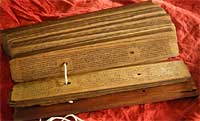
Kautilya's Arthashastra (4th century BC), a major theoretical treatise on statecraft, discusses administration and inter-state relations in detail. Because of its association with the Mauryan period, certain facets of the Mauryan dynasty can be inferred.
Charak Samhita, attributed to Charaka, and Sushruta Samhita, attributed to Sushruta, are important texts on ayurvedic medicine. Sushruta Samhita has special focus on surgery. The origins of both treatises may go back to 3rd / 2nd BC.
India gave the world the decimal system of notation, based on the concept of place values of digits and the use of zero. The oldest evidence of decimal place-value system is found in a 3rd century BC work on astrology called Yavanajatika, while the zero symbol, a dot, makes its appearance in the 2nd century BC in Chandasutra. Indian mathematicians were using the system fully by 5th century AD. The Europeans picked up this system in the 12th century AD from the Arabs, who had copied and transmitted the invention from India.
Aryabhatiya by Aryabhatta I (5th century AD) and Brahmasphuta-siddhanta by Brahmagupta (7th century AD) are important texts on astronomy. The latter is also a remarkable book on mathematics.
Kalidasa (4th century AD) is regarded as the greatest poet and dramatist of Sanskrit literature. Among his poetries are Raghuvamsha, Kumarasambhava and Meghaduta. He was also the author of the dramas Abhijanana-Shakuntala, Malvikagnimitra and Vikramorvashiya.
From South India, Tolkappiyam is a work on Tamil grammar. Tirukkural, written by Tiruvalluvar (5th - 6th century AD), deals with ethics, politics and love.
Harsha (Harshavardhana), who established an empire in the 7th century AD, was a playwright himself. Three of his plays are Ratnavali, Nagananda and Priyadarsika.
Vishakadatta wrote Mudrarakshasa (7th - 8th century AD) – a political drama of the times of Chandragupta Maurya – which illustrates the brilliance of his chief minister Chanakya, author of Arthashastra. His play Devichandragupta dramatises an event during the reign of the Gupta king Ramagupta.
Panchatantra (5th - 6th century AD) and Kathasaritsagara (11th century AD) are compilations of popular folk tales and fables, the former even traveling westwards through translations and diffusing into European literature.
Foreign Accounts
Traders, pilgrims, travelers and settlers have over that ages moved across the boundaries of the subcontinent, and as such references to India are found in many foreign texts.
Greek Accounts
The earliest foreign accounts of India are by the Greeks. The accounts, particularly the early ones, are a mix of facts and fables. They are the only source of information on Alexander's invasion in 326 BC. The most famous text is Indika by Megasthenes (ambassador of Seleucus Nikator to Chandragupta Maurya), which has actually survived only as fragments in later Greek and Latin works. Megasthenes describes India, its people, society and administration in the 4th century BC from a Greek perspective. The works of Plutarch and Arrian (1st and 2nd century AD) on Alexander also provide important clues to the emergence of the Mauryan empire after his departure.
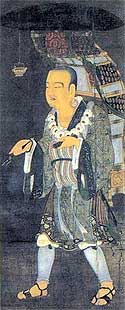
Works of authors like Strabo, and the anonymous text by a Greek sailor Periplus of the Erythraen Sea (1st century AD), are important from the point of view of history of Indian Ocean trade.
Chinese & Tibetan Accounts
Many Chinese monks journeyed to India to visit places linked with Buddhism. Fa Hien wrote of his travels (399 – 414 AD) in northern India focusing mainly on places and practices related to Buddhism. He also writes about the rule of Chandrgupta Vikramaditya of the Gupta dynasty. Hiuen Tsang traveled to India (626 – 644 AD) during the reign of Harsha, and gave a more descriptive account of his travels than Fa Hien, including details on Harsha, in his book Si-Yu-Ki. The Tibetan writer Taranath about the history of Buddhism in India.
Muslim Accounts
Alberuni's Tahqiq-i-Hind (11th century AD), an account of his travel to India, covers a variety of topics such as Indian scripts, sciences, philosophy, literature, religion, culture, social life and law. It has a great historical value, not the least of which is that it helped identify the beginning year of the Gupta dynasty.
The Arab traveler Sulaiman's account makes reference to India, and throws light on trade and certain aspects of Indian polity. The 14th century AD traveler Ibn Batuta's accounts supplement the information on Sultan Muhammad-bin-Tughlaq of the Delhi Sultanate.
List of References
Bibliography
| Indian Archaeological Sources | Indian Literary Sources | ||||
 Reconstructing the Past Reconstructing the Past |
 High School
High School Mathematics
Mathematics Sets & Basic Operations
Sets & Basic Operations